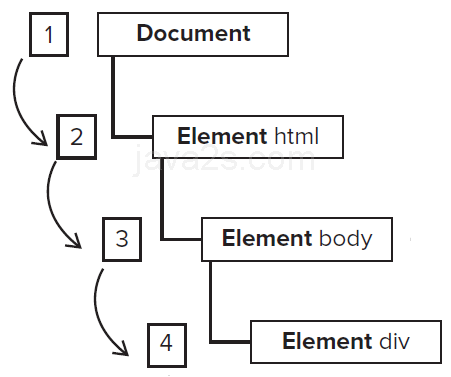Event Flow: capture, target, and bubbling
In this chapter you will learn:
Event life cycle
An event has three phases to its life cycle: capture, target, and bubbling.
The event capture phase is shown in the following image:

The event bubble phase is shown in the following image:

When the capture phase has finished, the browser triggers any listeners for the event type.
Calling the stopPropagation or stopImmediatePropagation
functions during the target phase stops the flow of the event and
the bubble phase won't be performed.
The following code shows the event capture phase:
<!DOCTYPE HTML><!--from j ava 2s . co m-->
<html>
<head>
<style type="text/css">
p {
background: gray;
color: white;
padding: 10px;
margin: 5px;
border: thin solid black
}
span {
background: white;
color: black;
padding: 2px;
cursor: default;
}
</style>
</head>
<body>
<p id="block1">
<span id="mySpan">This is a span. </span>
</p>
<script type="text/javascript">
var mySpan = document.getElementById("mySpan");
var textblock = document.getElementById("block1");
mySpan.addEventListener("mouseover", handleMouseEvent);
mySpan.addEventListener("mouseout", handleMouseEvent);
textblock.addEventListener("mouseover", handleDescendantEvent, true);
textblock.addEventListener("mouseout", handleDescendantEvent, true);
function handleDescendantEvent(e) {
if (e.type == "mouseover" &&
e.eventPhase == Event.CAPTURING_PHASE) {
e.target.style.border = "thin solid red";
e.currentTarget.style.border = "thick double black";
} else if (e.type ==
"mouseout" && e.eventPhase == Event.CAPTURING_PHASE) {
e.target.style.removeProperty("border");
e.currentTarget.style.removeProperty("border");
}
}
function handleMouseEvent(e) {
if (e.type == "mouseover") {
e.target.style.background = 'white';
e.target.style.color = 'black';
} else {
e.target.style.removeProperty('color');
e.target.style.removeProperty('background');
}
}
</script>
</body>
</html>
Stop Propagation
A parent element event handler can stop flow
of the event down toward the target by calling the
sstopPropagation or stopImmediatePropagation.
stopPropagation ensures that all of the event
listeners registered for the current element will be invoked.
stopImmediatePropagation ignores any untriggered listeners.
<!DOCTYPE HTML><!--from j av a 2s . co m-->
<html>
<head>
<style type="text/css">
span {
background: white;
color: black;
padding: 2px;
cursor: default;
}
</style>
</head>
<body>
<p id="block1">
<span id="mySpan">This is a span. </span>
</p>
<script type="text/javascript">
var mySpan = document.getElementById("mySpan");
var textblock = document.getElementById("block1");
mySpan.addEventListener("mouseover", handleMouseEvent);
mySpan.addEventListener("mouseout", handleMouseEvent);
textblock.addEventListener("mouseover", handleDescendantEvent, true);
textblock.addEventListener("mouseout", handleDescendantEvent, true);
function handleDescendantEvent(e) {
if (e.type == "mouseover" &&
e.eventPhase == Event.CAPTURING_PHASE) {
e.target.style.border = "thick solid red";
e.currentTarget.style.border = "thick double black";
} else if (e.type == "mouseout" &&
e.eventPhase == Event.CAPTURING_PHASE) {
e.target.style.removeProperty("border");
e.currentTarget.style.removeProperty("border");
}
e.stopPropagation();
}
function handleMouseEvent(e) {
if (e.type == "mouseover") {
e.target.style.background = 'white';
e.target.style.color = 'black';
} else {
e.target.style.removeProperty('color');
e.target.style.removeProperty('background');
}
}
</script>
</body>
</html>
Event bubble phase
The following code shows the event bubble phase:
<!DOCTYPE HTML><!-- j a va 2 s . c o m-->
<html>
<head>
<style type="text/css">
span {
background: white;
color: black;
padding: 2px;
cursor: default;
}
</style>
</head>
<body>
<p id="block1">
<span id="mySpan">This is a span. </span>
</p>
<script type="text/javascript">
var mySpan = document.getElementById("mySpan");
var textblock = document.getElementById("block1");
mySpan.addEventListener("mouseover", handleMouseEvent);
mySpan.addEventListener("mouseout", handleMouseEvent);
textblock.addEventListener("mouseover", handleDescendantEvent, true);
textblock.addEventListener("mouseout", handleDescendantEvent, true);
textblock.addEventListener("mouseover", handleBubbleMouseEvent, false);
textblock.addEventListener("mouseout", handleBubbleMouseEvent, false);
function handleBubbleMouseEvent(e) {
if (e.type == "mouseover" &&
e.eventPhase == Event.BUBBLING_PHASE) {
e.target.style.textTransform = "uppercase";
} else if (e.type == "mouseout"
&& e.eventPhase == Event.BUBBLING_PHASE) {
e.target.style.textTransform = "none";
}
}
function handleDescendantEvent(e) {
if (e.type == "mouseover" &&
e.eventPhase == Event.CAPTURING_PHASE) {
e.target.style.border = "thn solid red";
e.currentTarget.style.background = "blue";
} else if (e.type == "mouseout"
&& e.eventPhase == Event.CAPTURING_PHASE) {
e.target.style.removeProperty("border");
e.currentTarget.style.removeProperty("border");
}
}
function handleMouseEvent(e) {
if (e.type == "mouseover") {
e.target.style.background = 'black';
e.target.style.color = 'white';
} else {
e.target.style.removeProperty('color');
e.target.style.removeProperty('background');
}
}
</script>
</body>
</html>
Event bubbles property
Not all events support bubbling. Event bubbles property tells if the event supports bubble. It returns a true/false value.
<!DOCTYPE HTML><!--from j a v a2 s. co m-->
<html>
<head>
<style type="text/css">
span {
background: white;
color: black;
padding: 2px;
cursor: default;
}
</style>
</head>
<body>
<p id="block1">
<span id="mySpan">This is a span. </span>
</p>
<script type="text/javascript">
var mySpan = document.getElementById("mySpan");
var textblock = document.getElementById("block1");
textblock.addEventListener("mouseover", handleBubbleMouseEvent, false);
textblock.addEventListener("mouseout", handleBubbleMouseEvent, false);
function handleBubbleMouseEvent(e) {
document.writeln(e.bubbles);
}
</script>
</body>
</html>
Next chapter...
What you will learn in the next chapter: